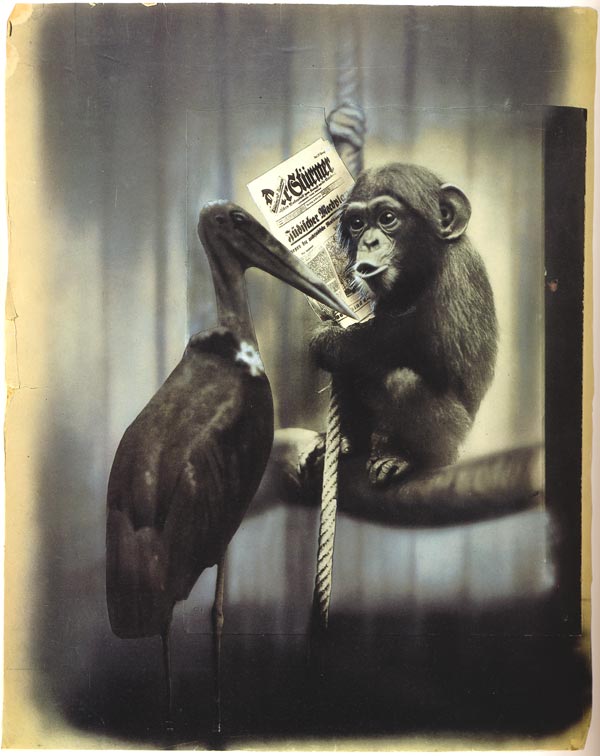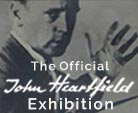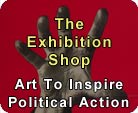Nazi Regime German Bigotry Mirrors Current Religious Bigotry
Famous Political Art Antiwar Masterpieces
Gespräch im Berliner Zoo(Conversation In The Berlin Zoo)

Conversation In The Berlin Zoo


Appeared:
AIZ
(Arbeiter–Illustrierte–Zeitung)
June 7, 1934
Prague, Czechoslovakia
Share Your Reaction To This Art
Visiting Scholar’s Commentary
Recent News Recalls Nazi Germany Bigotry
By John J Heartfield
In the Huffington Post on November 24, 2015, I read an article by Ryan Grenoble with the headline “This Daily Mail Anti-Refugee Cartoon Is Straight Out Of Nazi Germany.” The article is illustrated with an offensive cartoon showing Syrian refugees crossing into Europe bringing rats with them. Further down the page is a Nazi cartoon depicting Jews as rats wiped from the doorstep of Germany.
I was immediately reminded of my grandfather’s 1934 photomontage, “Conversation In The Berlin Zoo.” This work of art is a brilliant satiric commentary on how German bigotry was exploited by Hitler. Using the “other” as a lightening rod for a nations problems is too often used by indecent and immoral leaders to solidify their power.
Under the montage is the translated dialogue for John Heartfield’s photomontage:
Monkey: “Herr Streicher (a known Nazi) writes that the Jews are animals and so on – Will they soon be locked up in the Zoo?”
The Wise Marabou: “Phoo! They are to be placed on church spires. That’s much cleverer.”
Monkey: “Explain, why?”
The Wise Marabou: “The Jews are the best lightning conductors.”
John Heartfield’s political art brilliantly illustrated how those seeking political power by any means find it useful to use vulnerable groups as lightning rods to excite their supporters.
It seems as true in 2015 as it was in 1934.
JOHN HEARTFIELD’S ART MASTERPIECE ON GERMAN BIGOTRY
Written by Andrea Hofmann
Gespräch im Berliner Zoo. (Conversation In The Berlin Zoo)
“Conversation In The Berlin Zoo” appeared in the AIZ on the 7th of June 1934. It was one of several photomontages in which John Heartfield addressed anti-Semitism. It shows a monkey that has read “Der Stürmer” (The Striker) and discusses its leading article with a marabou.
Der Stürmer was an anti-Semitic hate sheet privately published by the fascist Julius Streicher. The newspaper was not the official Nazi party paper, nevertheless, it was widely read by Nazis and displayed in public display cases in order to reach a wider audience. The paper was founded in 1923 and mostly distributed in Germany, where its circulation grew steadily over the years. It was also available in Argentina, Brazil, Canada, and the United States. The newspaper reached its peak circulation in 1937 with a print run of about half a million copies.
The newspaper shown in Heartfield’s montage was a special edition of Der Stürmer from May 1934. In it, the paper claimed that Jews practiced ritual murders. Its headline read: “Jewish plan to murder non-Jewish mankind uncovered”.
Heartfield responded to this outrageous accusation with his photomontage “Conversation In The Berlin Zoo”. It’s text reads:
“Herr Streicher writes that the Jews are animals and so on – so they will probably be locked up in the zoo soon.”
The wise marabou replied: “Not at all! They will be put on church spires. That’s much more cunning.”
The monkey responded: “Tell me why?”
“Jews are the best lightning conductors.”
German Bigotry Background
John Heartfield was a famous anti-fascist artist. As a result, he became a target of Nazi aggression and persecution early on. Nazis would beat him up repeatedly and once even threw him from a moving tram. In April 1933, shortly after the Nazis came to power, the SS broke down the door of Heartfield’s studio. He had a narrow escape; in fact, he had to hide inside a garbage bin outside his apartment while the Nazis searched for him. He hid for hours while the thugs ransacked his studio and destoyed his art. In the aftermath of this event, John Heartfield fled from Berlin to Prague.
It’s clear the Nazis persecuted Heartfield for political reasons. Lesser known is the fact that Heartfield was also attacked because of his Jewish family background, as his grandparents were Jewish. According to Nazi race ideology his father was a Jew and Heartfield himself a “half-Jew”.
What being perceived as a Jewish artist entailed for Heartfield, among other things, can be read in the guidebook book for Nazi propagandists entitled “Das Politische Plakat: Eine Psychologische Betrachtung” (The Political Poster: A Psychological Approach) by Nazi-author Erwin Schockel and the Reichspropagandaleitung (central propaganda office of the National Socialists [N.S.D.A.P]), published in 1938, p.188/189. Schockel refers to Heartfield as a “dirty and shabbily dressed Jew” […] and calls him the “scum of the earth and prototype of Jewishness”. Schockel further claims that the Jew Heartfield – like all Jews – could only ape previous art works and was incapable of creating new values.
Heartfield’s Own Take On German Bigotry
When Heartfield fled to Prague in 1933, he arrived there without the necessary official documents and had to go for an interview with the Prague police department in order to get his papers. In his application for a residence permit, he described his escape from the Nazis and stated that his father was Jewish and his mother Protestant. He also declared that he belonged to no confession.
If we take Heartfield’s statement that he did not belong to any confession literally, he did not perceive himself as being Jewish or at least did not attach much importance to it. Nevertheless, he had to face the consequences of being constructed as a Jew by the Nazis. Apart from verbal and physical abuse, this also meant that anti-Semitic and racist laws, which were passed in Germany and later enforced in the occupied territories, applied to Heartfield as well. Anti-Semitism, therefore, was a personal matter to him. On top of everything else, Heartfield’s German citizenship was revoked in 1934. This meant he became stateless. He also ended up as number 5 on the Gestapo’s Most Wanted List.
Given these facts and Heartfield’s family background, it isn’t surprising that he created several montages specifically condemning anti-Semitism. Among them are “Same Brothers Same Killers”, AIZ 2 November 1933, “Conversation in the Berlin Zoo”, AIZ 7 June1934, “Hitler’s Best Friend Streicher, the Desecrator of Germany”, AIZ 15 August 1935, “Song of the Anti-Semites”, AIZ 19 September 1935, “Goebbels’s Recipe to Counter Food Shortages in Germany”, AIZ 24 October 1935, “The Doctrine of the Wolf”, AIZ 21 November 1935, and “Reservations – Jews Driven Like Cattle”, Reynolds News 10 December 1939. Heartfield also repeatedly ridiculed the Nazi belief system which claimed that the Aryan race was the most superior as in “New Chair At German Universities”, AIZ 31 August 1933 and “Voice from the Swamp”, AIZ 19 March1936.
Anti-Semitism remained a lifelong issue for Heartfield. In 1960, he took part in the exhibition Avowals in which artists protested against this type of German bigotry. He also gave a speech in which he sharply condemned the revival of fascism in the Federal Republic of Germany and admonished people to take anti-Semitic incidents seriously. In 1967, Heartfield once again condemned fascism and vowed to keep fighting against it. John Heartfield died in 1968 but his art lives on. It is a timeless warning against Nazis and fascism in the wake of renewed threats from the far-right across the world.
Gespräch im Berliner Zoo. (Conversation In The Berlin Zoo)
“Conversation In The Berlin Zoo” appeared in the AIZ on the 7th of June 1934. It was one of several photomontages in which John Heartfield addressed anti-Semitism. It shows a monkey that has read “Der Stürmer” (The Striker) and discusses its leading article with a marabou.
Der Stürmer was an anti-Semitic hate sheet privately published by the fascist Julius Streicher. The newspaper was not the official Nazi party paper, nevertheless, it was widely read by Nazis and displayed in public display cases in order to reach a wider audience. The paper was founded in 1923 and mostly distributed in Germany, where its circulation grew steadily over the years. It was also available in Argentina, Brazil, Canada, and the United States. The newspaper reached its peak circulation in 1937 with a print run of about half a million copies.
The newspaper shown in Heartfield’s montage was a special edition of Der Stürmer from May 1934. In it, the paper claimed that Jews practiced ritual murders. Its headline read: “Jewish plan to murder non-Jewish mankind uncovered”.
Heartfield responded to this outrageous accusation with his photomontage “Conversation In The Berlin Zoo”. It’s text reads:
“Herr Streicher writes that the Jews are animals and so on – so they will probably be locked up in the zoo soon.”
The wise marabou replied: “Not at all! They will be put on church spires. That’s much more cunning.”
The monkey responded: “Tell me why?”
“Jews are the best lightning conductors.”
German Bigotry Background
John Heartfield was a famous anti-fascist artist. As a result, he became a target of Nazi aggression and persecution early on. Nazis would beat him up repeatedly and once even threw him from a moving tram. In April 1933, shortly after the Nazis came to power, the SS broke down the door of Heartfield’s studio. He had a narrow escape; in fact, he had to hide inside a garbage bin outside his apartment while the Nazis searched for him. He hid for hours while the thugs ransacked his studio and destoyed his art. In the aftermath of this event, John Heartfield fled from Berlin to Prague.
It’s clear the Nazis persecuted Heartfield for political reasons. Lesser known is the fact that Heartfield was also attacked because of his Jewish family background, as his grandparents were Jewish. According to Nazi race ideology his father was a Jew and Heartfield himself a “half-Jew”.
What being perceived as a Jewish artist entailed for Heartfield, among other things, can be read in the guidebook book for Nazi propagandists entitled “Das Politische Plakat: Eine Psychologische Betrachtung” (The Political Poster: A Psychological Approach) by Nazi-author Erwin Schockel and the Reichspropagandaleitung (central propaganda office of the National Socialists [N.S.D.A.P]), published in 1938, p.188/189. Schockel refers to Heartfield as a “dirty and shabbily dressed Jew” […] and calls him the “scum of the earth and prototype of Jewishness”. Schockel further claims that the Jew Heartfield – like all Jews – could only ape previous art works and was incapable of creating new values.
Heartfield’s Own Take On German Bigotry
When Heartfield fled to Prague in 1933, he arrived there without the necessary official documents and had to go for an interview with the Prague police department in order to get his papers. In his application for a residence permit, he described his escape from the Nazis and stated that his father was Jewish and his mother Protestant. He also declared that he belonged to no confession.
If we take Heartfield’s statement that he did not belong to any confession literally, he did not perceive himself as being Jewish or at least did not attach much importance to it. Nevertheless, he had to face the consequences of being constructed as a Jew by the Nazis. Apart from verbal and physical abuse, this also meant that anti-Semitic and racist laws, which were passed in Germany and later enforced in the occupied territories, applied to Heartfield as well. Anti-Semitism, therefore, was a personal matter to him. On top of everything else, Heartfield’s German citizenship was revoked in 1934. This meant he became stateless. He also ended up as number 5 on the Gestapo’s Most Wanted List.
Given these facts and Heartfield’s family background, it isn’t surprising that he created several montages specifically condemning anti-Semitism. Among them are “Same Brothers Same Killers”, AIZ 2 November 1933, “Conversation in the Berlin Zoo”, AIZ 7 June1934, “Hitler’s Best Friend Streicher, the Desecrator of Germany”, AIZ 15 August 1935, “Song of the Anti-Semites”, AIZ 19 September 1935, “Goebbels’s Recipe to Counter Food Shortages in Germany”, AIZ 24 October 1935, “The Doctrine of the Wolf”, AIZ 21 November 1935, and “Reservations – Jews Driven Like Cattle”, Reynolds News 10 December 1939. Heartfield also repeatedly ridiculed the Nazi belief system which claimed that the Aryan race was the most superior as in “New Chair At German Universities”, AIZ 31 August 1933 and “Voice from the Swamp”, AIZ 19 March1936.
Anti-Semitism remained a lifelong issue for Heartfield. In 1960, he took part in the exhibition Avowals in which artists protested against this type of German bigotry. He also gave a speech in which he sharply condemned the revival of fascism in the Federal Republic of Germany and admonished people to take anti-Semitic incidents seriously. In 1967, Heartfield once again condemned fascism and vowed to keep fighting against it. John Heartfield died in 1968 but his art lives on. It is a timeless warning against Nazis and fascism in the wake of renewed threats from the far-right across the world.

